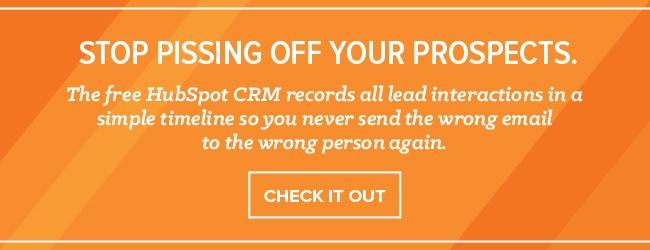
In 2012, two Harvard sophomores set the Guinness Book record for the world’s longest phone call: 46 hours, 12 minutes, 52 seconds, and 228 milliseconds.
Hopefully you’ve never been on the phone that long, but let’s be honest -- when working with someone who loves to jabber, conversations can feel pretty interminable. Even the most tactful reps struggle to keep their chatty prospects in line without cutting them off … and looking like a jerk in the process.
Nonetheless, it’s crucial to verbally rein overly talkative prospects in. Neither of you benefit from prolonged, rambling calls: In fact, the sooner you get down to business and off the phone, the sooner you (and they) can tackle other tasks.
Read on for the top five ways to diplomatically curb a never-ending conversation.
1) Set a Clear Agenda
Agenda-setting is an important part of every sales conversation. But when your prospect is a talker? It’s absolutely crucial. After all, the more opportunities you take to remind them of your mutual purpose, the better.
With that in mind, make sure to set your agenda before you dive in -- preferably while you’re booking the call or meeting. If you accidentally neglect this step, send them an email a day or so before your appointment with some homework (HubSpot VP of Sales Pete Caputa recommends asking them to mull over some questions or review some information).
Once the meeting begins, set expectations by mentioning its scheduled length. Then ask if there's anything the prospect wants to cover. This shows respect for their needs; plus, since many prospects ramble simply because they want to feel heard, requesting their agenda can preemptively cut down on their verbosity.
Finally, touch on the topics you want to address.
Here’s how that might look:
You: “So, looks like we’ve got 30 minutes. Was there anything you were hoping to discuss today?”
Prospect: “I’d like to know more about your track record with companies our size.”
You: “Great, then let’s start with a couple case studies. After that, we can move to your specific goals and how AeroStream can help. Lastly, let’s talk timeline. Does that sound good?”
2) Ask Yes-or-No Questions
For most prospects, asking open-ended questions is a great way to put the prospect at ease and uncover unexpected and useful information. The operative word? Most.
When you’re dealing with ultra-chatty prospects, asking something broad is essentially handing over the conversational reins and inviting them to ramble. You need to keep the call as focused as possible -- which means framing your questions so they can be answered with “yes” or “no.”
For example, rather than asking, “What are your top priorities right now?” you’d ask, “Would you say one of your top priorities is reducing employee turnover?”
If a yes-or-no question feels a little too narrow, then give the prospect two choices, like so: “Are you more concerned with reducing employee turnover, or improving your internal promotion rates?”
3) Politely Redirect the Conversation
You don’t want to be rude, so when the prospect starts going down conversational rabbit holes, you might be tempted to humor them. But remember that you’re the one in control.
If they start talking about something completely unrelated, wait till they’ve paused, acknowledge their train of thought in a single sentence, then smoothly redirect the conversation. This approach lets you get things back on track without being impolite.
Here’s some sample dialogue to show you how it’s done:
Prospect: “… and that’s why I never stay anywhere on the Cape but Falmouth.”
You: “I’ve heard Falmouth is lovely. By the way, which tools is your team currently using to send files internally?”
Prospect: “Well, we’ve been using a combination of …”
4) Remind Them of the Time
Referencing the time is always tricky. You don’t want to sound impatient, but you also want to remind them you’ve got unfinished business and a ticking clock.
To do so tactfully, reference the prospect’s busy schedule.
For instance, you might say, “I apologize for breaking in -- we’ve only got 10 minutes left, and I’m sure you’ve got other things to do after this. Do you want to move to the [next item on the agenda]?”
Alternatively, you could interject with, “[Name], I just caught the time, and we’ve only got 15 minutes left. I know you wanted to discuss your Q3 objectives -- should we move to that? I’d love to finish hearing about your fishing trip after, if time permits.”
5) Summarize What They’ve Said
It’s fantastic if your prospect is forthcoming about their problems (if only they all were!). But hammering the same point home over and over and over again isn’t a great use of anyone’s time.
If you notice your prospect is talking in circles, show them you’ve gotten their point by quickly summarizing it.
Imagine your prospect has spent the last 10 minutes sharing how poor customer ratings have impacted her business.
To show empathy while simultaneously moving to a more productive topic, you might say, “I’ve worked with more than 20 companies in your space in the last five years, and they all say one-star reviews have really hurt them. I’ve got a couple ideas on how to boost your reviews. First, we could …”
It’s easy to feel like you have to indulge big talkers -- at least, if you want to get the sale. But participating in long, irrelevant discussions is unproductive for both you and the prospect. With these five strategies, you can redirect the conversation to where it counts.
(Psst: Not clear on the difference between rapport building and rambling? Check out our guide to creating rapport with leads to learn the difference.)








![Confused About I.E. vs. E.G.? When to Use Each [With Examples]](https://www.hubspot.com/hubfs/ie-vs-eg-fi%20%281%29.jpg)



